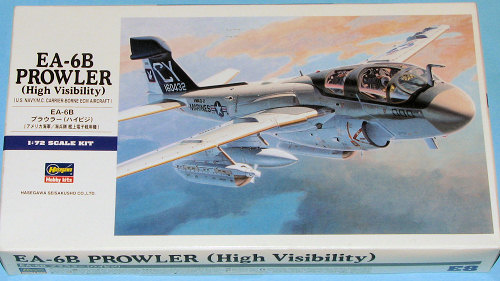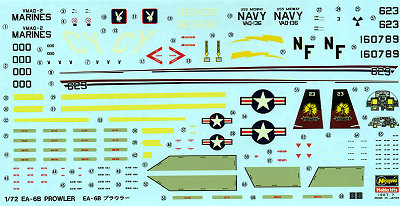
| KIT: | Hasegawa 1/72 EA-6B Prowler (High Visibility) |
| KIT #: | 00538 (E 8) |
| PRICE: | 1200 yen |
| DECALS: | Two options |
| REVIEWER: | Scott Van Aken |
| NOTES: | Basic boxing |

| HISTORY |
| THE KIT |
 Not exactly your cutting edge kit, the Hasegawa EA-6B has been around at least 20 years if not longer. Part of Hasegawa's initial generation of engraved kits, the original boxings came with tinted canopy sections, those having been replaced by standard clear plastic.
Not exactly your cutting edge kit, the Hasegawa EA-6B has been around at least 20 years if not longer. Part of Hasegawa's initial generation of engraved kits, the original boxings came with tinted canopy sections, those having been replaced by standard clear plastic.
I'm not sure which of the myriad of electronic updates this is supposed to be, but my guess is that it is an ICAP version. This is due to the lack of HARMs included with the kit as anything else. Generally, the molds have held up well. The most telling sign of age is a large section of flash on one engine intake section. There are ejector pin marks on the main gear and nose gear struts, as well as on the inside of the gear doors. I'd expected more of them, but was pleased not to see them on the wheels or pylons.
The interior is about what you'd expect from Hasegawa with four rather basic seats, lightly detailed side consoles and decals for the front and rear instrument panels. Both intake and exhaust are quickly blanked off. The crew boarding ladders are provided and can be posed deployed if one wishes. Canopies can be posed open. The forward one comes in two pieces and needs to be cemented together. Removing the seam will be a bit difficult. For stuff under wings you have the option of five jammer pods and three fuel tanks. Rarely if ever would you find a plane carrying five pods, one or two being the norm. Two optional nose refueling probes are provided.
 Instructions are standard Hasegawa as well with Gunze color callouts. Since these are early EA-6Bs, they are both in the gloss light gull grey and white scheme with tan radomes and pylon leading edges. The leading edges of the flight surfaces are a yellow tape that is provided as part of the decal sheet. Wing and stab walk areas are also on the decal sheet. These should be dark gull grey but are a somewhat greenish grey on the sheet.
Instructions are standard Hasegawa as well with Gunze color callouts. Since these are early EA-6Bs, they are both in the gloss light gull grey and white scheme with tan radomes and pylon leading edges. The leading edges of the flight surfaces are a yellow tape that is provided as part of the decal sheet. Wing and stab walk areas are also on the decal sheet. These should be dark gull grey but are a somewhat greenish grey on the sheet.
Markings are for two planes. One is from VMAQ-2 and shown on the box art. The canopy section and fin are painted black on this aircraft. The other is from VAQ-136 which was aboard the USS Midway. Hasegawa always seems to provide a CAG-5 aircraft from the Yokusuka-based carrier when it does a base kit. Decals are standard old-style types which are thick and have white markings in an ivory shade. These decals generally hate setting solutions so one has to be careful when using them.
| CONCLUSIONS |
So there you have it. Your other choice of an EA-6B in this scale is by Matchbox. Most will pick this one when deciding to build a Prowler. I can recall doing this one back when I was not as good as I am today. The fit of the intake and exhaust sticks in my mind as does the lower fuselage insert. Nowadays I don't expect to have any problems in that area. Though the instructions don't mention a need, I'd also stick some weight in the nose just to be sure. There are aftermarket decals for this, though I doubt many of them are new. Just what has to be done to the kit to update it to ECAP II or more modern standards is not known. Perhaps one of you knows what needs to be done, at least externally.
Overall, I know that this can be built into a beauty as I've seen them done so.
March 2007
| REFERENCES |
Naval Historical Center
Thanks to me and some careful shopping amongst the vendors at a recent show. If you would like your product reviewed fairly and fairly quickly by asite that has over 350,000 visitors a month, please contactme or see other details in the